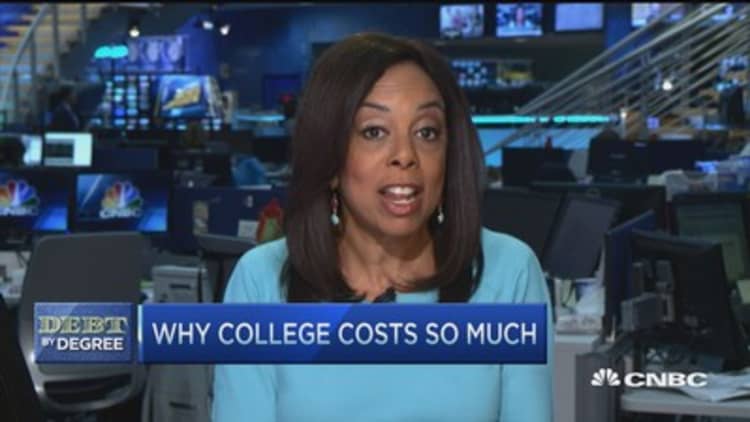
Whether you dream of exotic travel, carefree hours with grandchildren, or just a chance to put your feet up for once, retirement fantasies are something many Americans enjoy.
It helps, though, if you can afford to retire. And new research suggests that student debt, of all things, may be the latest challenge facing people saving for their so-called golden years.
The Center for Retirement Research at Boston College has examined what would happen if all workers today had the same levels and incidence of student indebtedness as recent college graduates.
The result: The share of people at risk of not having enough money for a secure retirement would rise from 51.6 percent, which the center called "already alarming," to 56.2 percent. That may not sound like much, but with more than 150 million Americans in the civilian labor force, such a shift could affect millions of people.
Put another way, if working Americans of all ages had the same student debt exposure as recent college graduates, "the impact would be similar to that of increasing the normal Social Security retirement age from 65 to 67," said Anthony Webb, a senior research economist at the Boston College center.
The share of Americans facing retirement risk, defined as not being able to get within 10 percent of a target income replacement rate in retirement, has been rising in recent years. The center's retirement risk index in 1989 stood at 30 percent, but it has increased almost steadily ever since. Rising life expectancies have meant that seniors' savings have to last longer, and in recent years, low interest rates have made it harder to build low-risk savings for retirement.
There have been other shifts as well, notably in the realm of student debt. More people have been borrowing for higher education, and their average indebtedness has grown as well. Some 69 percent of of the Class of 2014 graduating from public or nonprofit schools had student debt, up from 65 percent 10 years earlier, and the amount they borrowed averaged $28,950, up 56 percent from $18,550 a decade before, according to the Institute for College Access & Success.
These higher debt levels are already affecting millennials' lives: They are buying homes later, with homeownership among those under age 35 dropping from 40.4 percent at the end of 2009 to 34.7 percent at the end of 2015. They also tend to be cautious investors.
Millennials are also waiting to start families. The average age for having a first child hit 26.3 in 2014, up from 22.7 in 1980, according to the Centers for Disease Control and Prevention.
What the Boston center found, though, suggests that the effects of student debt may extend far beyond the appearance of that first child.
"If you are going to spend more on repaying student loans, then something else has to give," Webb said. "The question is what that something should be. If the something else is saving for retirement and buying a home, then households are going to face difficulties down the line. If they are not going to cut back on retirement savings and postpone buying their home, then the thing that has to give is current consumption."
Only a relatively small share of the elderly population still holds student debt. A 2014 report by the Government Accountability Office put the figure at 4 percent of households headed by people ages 65 to 74. And while households headed by people 65 and older held $18 billion in student loan debt in 2013, according to the study, that figure was dwarfed by the more than $1 trillion in total student loan debt outstanding.
Still, student debt does significantly increase risks during retirement, the center found, especially for those who do not finish college. Some 67.1 percent of that group was at risk, compared with 49.2 percent without student debt.
Even people without high levels of student debt are facing financial pressures that have shifted over the decades, not least the change in responsibility for retirement security. Working households today are far more likely to be responsible for their retirement security than working households 20 or even 15 years earlier. And while almost two-thirds of workers in 2014 reported having saved for retirement, 6 in 10 workers and/or their spouses had less than $25,000 socked away, according to a study by the Employee Benefit Research Institute.
Those challenges leave people with much less flexibility to contend with education loans, but Webb cautioned against taking the wrong message from the study.
"The message is not 'Don't go to college,'" he said. "We know that college is a good investment and increases your lifetime earnings. In general having a college education is a good thing. But it is, unfortunately, becoming a more expensive thing."





